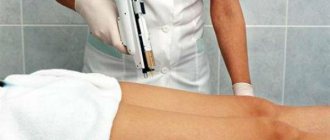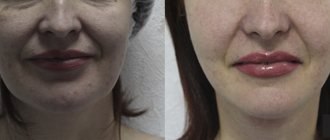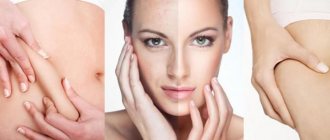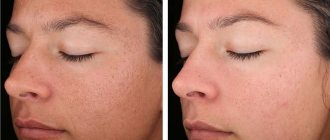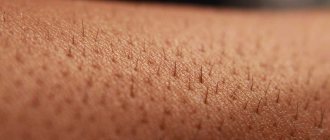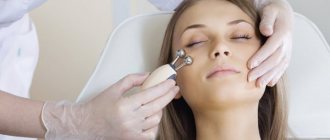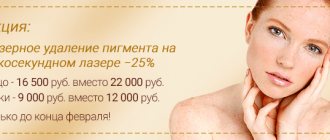What is laser nanoperforation?
This procedure has been used for more than two decades and is becoming increasingly popular among many rejuvenation techniques. The principle of operation of the device is the ability of cells to self-heal.
The device has a special attachment that splits the laser beam into many small ones. Thus, many microchannels are created through which the laser penetrates the dermis and damages it.
After a certain period of time, the damaged areas are restored, young elastin and collagen fibers are formed. The skin turns a little red after the procedure, but after a few days this phenomenon is replaced by peeling of the epidermis.
The advantage of this method is the almost absolute remodeling of the skin, which grows after 2 weeks. This is a very big plus when nanoperforation of facial skin is performed, because in this area the dermis has different thickness and mobility.
To notice the result, just one-time procedure is enough. The session lasts up to 20 minutes. As a result, a long-term effect is achieved. If there are indications for it, then LN is performed from the age of 25.
The most effective result after laser is noticeable in women 50-55 years old. Older women may be left with fine spider veins and deep wrinkles because the cells' ability to repair themselves decreases significantly with age.
Indications and contraindications
The main reason for prescribing the nanoperforation procedure is the prevention of age-related changes in facial skin, as well as the fight against existing signs. She copes well with moderately expressed aesthetic problems. The most suitable age for the procedure starts from 35 years old, but if necessary, you can start from 25 years old. The technique is also used to rejuvenate the skin on the hands and décolleté. After 55 years of age, the procedure can provoke the appearance of spider veins. This is due to an age-related decrease in the ability of cells to recover. The effectiveness of nanoperforation is manifested in the following cases:
- scars, stretch marks, cicatrices;
- strong pigmentation associated with age or season;
- expression wrinkles;
- ptosis, sagging soft tissues;
- heterogeneity of the skin structure;
- unhealthy complexion;
- excessive oily skin, enlarged pores.
The procedure may be limited by a list of contraindications that are typical for most complex effects on the skin:
- pregnancy, lactation;
- menstruation;
- hemophilia;
- hepatitis, thyrotoxicosis, diabetes mellitus;
- oncology;
- exacerbation of chronic diseases;
- diseases of the endocrine and circulatory system;
- infection, high body temperature;
- psoriasis, herpes and other skin diseases.
Contraindications and indications for facial nanoperforation
The big advantage of the procedure is the absence of pain during it. In addition, there are no cosmetic defects such as blisters.
The laser beam can be used on any part of the body for the following indications:
- Pigment spots, uneven and dull complexion;
- Acne, the scars it left;
- Enlarged pores, increased oil content;
- Mimic, medium and deep wrinkles;
- Flabbiness and sagging skin;
- The presence of stretch marks and scars after injuries, operations, pregnancy;
- Uneven terrain.
Contraindications:
- Pregnancy, lactation;
- Diabetes mellitus and other endocrine pathologies;
- Infection in the body;
- Blood clotting disorder;
- Do not carry out during menstruation;
- Acute and chronic skin lesions caused by viruses, fungi, bacteria.
Care after laser nanoperforation
At the end of the procedure, the surface of the skin is slightly reddened. Soon it will return to its normal, but healthier color. Then for several days there is slight peeling of the top layer. To avoid more serious problems, a little rehabilitation is needed:
- on the first day you should give the skin rest;
- later hygiene is carried out with an antiseptic;
- You need to apply a regenerating and anti-inflammatory cream for several days;
- You can’t use decorative cosmetics for a week;
- You should avoid ultraviolet rays for half a month and apply sunscreen before going outside;
- It is better to refrain from thermal procedures (baths, hot baths), as well as swimming, for the same amount of time;
- For 2 weeks you cannot use scrubs, products containing alcohol, or do peelings.
Recovery after the procedure
After the session, a variety of cosmetic and medicinal products are necessarily used to promote skin regeneration. The cosmetologist will recommend a drug, but often these are Sicalfate, Bipanten and other similar creams that can be purchased without a prescription at the pharmacy.
If the procedure was carried out in the summer, then it is necessary to protect the skin from sunlight using special products with an SPF factor of at least 50. But experts recommend minimizing the time spent in the open sun as much as possible for 2 weeks from the date of the procedure.
You cannot speed up the peeling process. The dermis regenerates from 10 to 15 days. After a set time, young, pink, tightened and fresh skin begins to appear. It is not recommended at this stage to use decorative or any other cosmetics for the face (gels, nourishing and foundation creams, powders, etc.).
For older women, one procedure may not be enough. Sometimes the course consists of 4 visits, the interval between which is several weeks. In this case, the final effect can be achieved after 3 months. If necessary, nanoperforation can be performed no more than once a year to maintain the skin in normal condition.
Procedure
The specialist cleanses the skin with a special lotion and places an attachment on the device that breaks the laser into many nanobeams. The facial treatment lasts about 20 minutes. There is no need to use painkillers. The patient may feel a slight burning or tingling sensation that is not pain. However, you should first consult a specialist regarding the use of an anesthetic. The painlessness of the procedure depends on your personal pain threshold.
The redness that occurs after the procedure disappears the next day. It is caused by the expansion of capillaries and indicates the activation of rejuvenating processes in the skin. The next day, the reddened skin begins to peel off. During this period, it is necessary to treat the skin with regeneration-enhancing agents “Bepanten” and “Sicalfate”, but the peeling process itself should not be accelerated.
The first couple of weeks it is necessary to protect the skin from sun exposure by using protective creams with a UV filter. You should avoid staying in the cold, visiting the sauna, solarium, or bathhouse. The use of decorative cosmetics during the period of active peeling should also be avoided. A noticeable remodeling effect appears gradually over two or three weeks with careful care. The duration of the course depends on the individual characteristics of a person’s skin. After 2-3 sessions, with a break of a month, the intended goal can be achieved. If you follow all the doctor’s instructions for skin care after nanoperforation, the stable effect will last up to 5 years.
How does laser nanoperforation occur?
The procedure is carried out only with special equipment, which must be operated by a specialist who has completed training in this technique. When choosing an office, the main criteria for reliability and safety are the availability of relevant documents and positive reviews.
No special preparation is required before the event. There is also no need for pain relief.
After the end of irradiation, the treated areas turn red, but, as mentioned above, this is not caused by thermal injury, but is the result of heating: the capillaries expand under the influence of laser pulses.
Blood supply has a positive effect on metabolism, so a red complexion can be regarded as the beginning of positive changes. Often the skin returns to its usual color after 1-3 days.
Benefits of the procedure
- Suitable for all skin types;
- Can be performed on an outpatient basis;
- Rehabilitation will not take much time, since local thermolysis of the dermis is carried out without affecting the epidermis. After the session, the patient can return to normal activities within a few hours;
- The aging process slows down, which allows you to maintain the effect for many years;
- No discomfort or pain;
- The maximum session duration is 60 minutes;
- The ability to adjust the laser depth allows you to eliminate many other defects on the body;
- Nanoperforation for old scars and stretch marks is performed only once, but the positive effect lasts throughout life. In the presence of profound phenomena, the number of visits is increased to 4, and LN sessions can be combined with other procedures;
- Laser perforation can be used as a means of preventing aging.
The use of laser in medicine and cosmetology allows not only to carry out rejuvenation procedures, but also to correct problem areas of the skin. At the same time, the process is as fast, painless and safe as possible.
A variety of mechanical and laser peels remove the upper layers of the dermis, thereby smoothing its surface. As a result, the regeneration process is activated, deep defects become less noticeable. Laser nanoperforation provokes an active regeneration process without damaging the skin.
In most cases, experts advise combining all of the above procedures to achieve the most positive effect.
The number of procedures is individually prescribed in each specific case, guided by the condition of the skin, how long ago the defects appeared, and the individual characteristics of the body.
Laser nanoperforation - personal experience
The post promised yesterday, continuing the series of self-exposures - this time my experience of performing laser nanoperforation on my individual face :)
But first, a couple of phrases on the history of the issue and a few policy statements :). I grew up in a family where my dad was a renowned orthopedic dentist and my mom was (and still is) an oral and maxillofacial surgeon. Therefore, my childhood was quite specific. Firstly, I have had my teeth treated all my life, as far back as I can remember. (Not because my parents showed excessive zeal, but because I had teeth - literally tear them off and throw them away. I suspect that a child with such teeth, if he were born in some other family, would not have survived at all. But with me there was a chance!) Secondly, the parents endlessly discussed among themselves bridges, molars, premolars and birth defects like cleft palate and cleft jaw. (These Hare Mouths and Wolf Jaws were my childhood fairy-tale heroes. I assumed that they were as real as Piggy, Stepasha and Moidodyr.) Thirdly, my parents also watched TV in a peculiar way. While watching the “Time” program, they discussed Angelina Vovk’s bite. Watching some operetta, my mother sighed, “They could have done Shmyga’s plastic surgery better.” And watching the demonstration on November 7, when the camera spent a long time scanning the faces of Politburo members on the podium of the Mausoleum, turned into an analysis of the work of Kremlin dentists at home. And as “Funny Pictures,” I sometimes looked at cut-out upper and lower jaws and noses in cross-section from textbooks on maxillofacial and orthopedic dentistry. By the way, there were a lot of “before” and “after” pictures, but they could be trusted, since Photoshop had not yet been invented.
I say all this now so that it is clear:
a) I perceive plastic medicine and aesthetic cosmetology as something completely everyday;
b) I am not afraid of blood, injections, swelling, stitches, bruises and other “related products”;
c) I don’t believe in the myths and legends that ordinary people surround this area with;
d) I believe that if some defect (no matter congenital or acquired) torments you, then you need to get rid of it and stop suffering; but I also believe that if you can stop tormenting in another way - for example, by explaining to yourself that with this shape of your nose you can be happy without a scalpel, then it’s better to explain and not do anything with your nose.
e) I don’t believe in the “before” and “after” photographs that clinics equip their advertising modules with, because Photoshop has long been invented. I know that a good result is often not visible in a photograph, a bad result is not obvious in a photograph, and that the concepts of “good result” and “bad result” can be very different from each other, that is, from the point of view of the doctor, the result may be good, but from the patient's point of view - bad. Because the patient may have a strong image of Marilyn Monroe in his head, whom he (the patient) wants to be like at all costs. But I, of course, understand that these “before” and “after” photographs are still terribly interesting to look at.
f) I believe in good doctors - that they exist. And I know that even they are not Gods and are not immune from mistakes. No one is safe from them.
And no, I didn’t do any plastic surgery on myself. But yes, I have been injecting hyaluronic acid injections in different types in different places for quite a long time :) I resorted to facial mesotherapy, reviews of which are very varied, but I finally decided. And yes, I did this same laser nanoperforation several times, which I now want to write about. And I believe that all this should not be done when everything is already obvious to everyone, and all your photos can already be safely placed in the “before” category. And then, when you start to not like something about yourself, but others still like you out of habit, and they don’t notice anything. (Here, of course, a certain amount of common sense is required in the head, but with this - who is lucky :)
There is a cosmetologist in my life whom I trust, although I do not often annoy him with my presence. The cosmetologist's name is Evgeniy Karpov. Zhenechka (sorry, Evgenia Leonidovna) is an expert when it comes to injections, laser peels, improving the shape of the lips and, in general, all that part of cosmetology that is somewhere in the middle between plastic surgery and massages-masks-and-other-pleasures. Doctor Karpova receives her in Polyanka, which is completely devoid of any glamor and pathos. But I personally don’t care - I don’t go there for pathos, to be honest :))
Here is my cosmetologist at work (the patient is not me):
And here is the Cosmopulse device, on which Dr. Evgenia Karpova performs laser nanoperforation. This is a procedure roughly similar to Fraxel - enlarged pores are removed from the skin using a laser beam, the effects of acne are eliminated, wrinkles of varying degrees are erased, and the complexion is evened out. Along the way, there is a small but pleasant bonus in the form of a lift. (You can also remove scars and stretch marks, but I didn’t have fun with that. Although there are a couple, you can have fun :))
In general, I know about myself - when I actively begin to dislike myself, then it’s time.
The main difference from Fraxel is a different type of laser. Fraxel uses a cold erbium laser, here it is a hot CO2 laser. Erbium does not affect those layers of skin that are deeper; this one works mainly at depth. On the outside, skin renewal occurs both here and there. At depth - only in cases where the cosmetologist works with CO2 laser. (True, fraxels have recently proliferated and acquired a lot of different attachments, so perhaps they have some versions similar to this one). The Cosmopulse laser beam does not remove the skin, it passes through it, only those places through which it works are damaged - that’s why the procedure is called “nanoperforation” and not “peeling”, for example.
Naturally, the depth of the beam and its intensity may vary. And they vary precisely by the doctor. Well, that is, it is the doctor who sets the regimen. This unit has five parameters, they can be changed and different programs can be obtained - and, accordingly, different results, depending on what the patient needs. That’s why, perhaps, there are so many conflicting reviews of these procedures—some people like them, others say they’re not very effective, others say they’re too traumatic. In fact, a lot depends on the skill and experience of the doctor - which zone to go through, where to add, where to subtract, where to push, where to let go. I don’t delve into these subtleties, I just trust Dr. Karpova. The nozzle through which the laser beam passes looks like this:
The next picture is for those who like “before” and “after” photos. This is me - “before”. Anesthetic cream was applied to my face. But in this case, I almost don’t care, because I got into the procedure just after the dentist, who, having previously injected a bunch of anesthetics, cut into my upper jaw and screwed the formers into the implants. (Yes, yes, my backstory about dental torment was precisely this. I still treat teeth, yeah. I’ve been enthusiastically doing dental implants for the last year. Not because the old ones were bad. Because there are practically no old ones left:) As always, it’s not visible in the photo, but my jaw hurts :)) And yes, one of the motives for going for nanoperforation right now was that with a swollen jaw, I still have to cry for three days and sit at home, so why waste my time lose?!
Well, after 40 minutes, when my face completely became wooden due to general anesthesia, the process began. If you look closely, you can see how in some frames my skin is still intact, and in others there is white dust. This dust is actually laser-burned epithelium.
To make it easier to see, here’s a close-up:
The sensations with all this are not the most pleasant, but quite tolerable. But here you have to be careful, of course: everyone’s pain threshold is different, and their ideas about “hurt” and “not painful” are also different. And not everyone, of course, has something to compare with. I now compare everything with the process of implantation. Compared to this, it doesn't hurt. I no longer like the smell of my own burnt skin, which is inevitable during the process - the laser burns it. Immediately, you know, some rudimentary memories of concentration camps come to mind :) But perhaps this is personal :))
In some places the pain is higher (for example, on the forehead and on the cheekbones, where the bones are close), in others it is lower. It’s nice (although is the word “pleasant” appropriate here?:) that Dr. Karpova treats all areas of the face, neck and décolleté with this laser. Even the upper and lower eyelids. Even hands. Hands, by the way, without any anesthesia at all - it’s quite possible to endure.
All this lasts 15-20 minutes. (In my case, it lasted about 30 minutes, but this is because we were not only doing business, but also posing in front of the camera. Especially me:) After this, his face burns, despite the anesthesia - that is, he feels hot and cold at the same time. The advertisements say that you look like you've been sunbathing in a solarium. Well, I don’t know if it’s possible to re-tan in this way - I’ve never succeeded :) Here’s a photo from the “immediately after” series. Hanged mainly to prove that “after” you don’t lose the ability to smile. Some roughness of the muzzle, in my opinion, can also be seen.
The most unpleasant thing in this story is the next morning. There is no anesthesia anymore, the face is burning without any cooling, plus swelling. The size of the swelling depends. The first time I did this nanoperforation, it was simply many times larger - it coincided with the cycle, in the second phase I generally swell with or without reason. The second time it’s easier. This (third) time can be considered close to ideal :) This is what this “ideal” looks like:
Gradually, the face stops burning, but begins to actively roughen. Dr. Karpova gives all patients a tube of Bipanten cream (sold in all pharmacies at some ridiculous prices, and a great thing, by the way, when some wounds need to be healed or the consequences of hair removal are reduced to zero) and a small “drip” of Unigel. Unigel is a drug that should be lubricated on the face after washing twice a day. It is cloudy white, odorless, and, according to Dr. Kryukova, works wonders. Well, I don’t know whether it’s miracles or not, but on the second day my swelling completely went away. And here's what's left:
Such a mesh, as if gauze had been placed on the face, pressed firmly - and traces remained. This is the evening of the second day. What will happen on the third, fourth and fifth, I already know from experience - active peeling, from under which very smooth, very delicate and almost flawless skin will begin to appear, only slightly too pink. Then there will be more areas of pink skin, and fewer “peeling” areas.
Then I'll just look really good.
But, despite the fact that I know all this, I will still make another post-photo report. And I’ll add some details and feelings that I don’t remember now.
And more good news - Dr. Evgenia Karpova agreed to be a beauty insider's expert in cosmetology. Soon we will come up with a permanent page where you can ask her questions. In the meantime, you can ask questions here in the comments.
PS: I almost forgot about the prices: nanoperforation of the face - 18,000 rubles, face + neck + décolleté - 37,000 rubles, eyes or hands separately - 5,000 rubles, scars individually - 1,500.
Nanoperforation results
The result of the Nanoperforation procedure can be seen after two weeks. Wrinkles gradually disappear, pores become smaller, and the skin structure improves. Over the course of several months, you can observe positive dynamics in skin changes! During this time, the structure of the skin improves, new fibers are formed, and an amazing rejuvenation effect is created. To enhance the effect, experts recommend undergoing several nanoperforation sessions in Stavropol.
before after
before after
The advantages of the nanoperforation method are the possibility of application on various types of skin of the hands, face, neck and décolleté. In addition, at the aesthetic medicine center “Ray of Beauty” it is possible to combine the laser nanoperforation method with other cosmetic procedures, for example, with plasma lifting. This combination will enhance the resulting rejuvenation result.
Contraindications to nanoperforation
Nanoperforation is contraindicated for pregnant and lactating women, as well as people suffering from blood diseases and diabetes.
Contact: Stavropol, st. Lomonosova, 23
Phone: (8652) 423-423, 355-355
Consult a specialist about the presence of contraindications.
Contraindications to laser nanoperforation
Despite all its safety, nanoperforation, like any other procedure, has a number of contraindications:
- pregnancy and breastfeeding;
- diseases of the endocrine system (thyrotoxicosis, diabetes mellitus, etc.);
- acute infectious diseases;
- low blood clotting;
- chronic and acute diseases of the skin of a bacterial, viral or fungal nature;
- period of menstruation.
At a preliminary consultation with a specialist, you must inform about all previous injuries, surgical interventions, serious diseases and characteristics of the body. Do not be embarrassed: if you hide some important information about your health, the consequences of the procedure can be very disastrous.
The skin rejuvenation procedure can be carried out at any time of the year, regardless of the patient’s age and gender, it is only important to take into account the state of health.
